
Pentatomidae is a family of insects belonging to the order Hemiptera, generally called shield bugs or stink bugs. Pentatomidae is the largest family in the superfamily Pentatomoidea, and contains around 900 genera and over 4700 species. As hemipterans, the pentatomids have piercing sucking mouthparts, and most are phytophagous, including several species which are severe pests on agricultural crops. However, some species, particularly in the subfamily Asopinae, are predatory and may be considered beneficial.

The Australian flatback sea turtle is a species of sea turtle in the family Cheloniidae. The species is endemic to the sandy beaches and shallow coastal waters of the Australian continental shelf. This turtle gets its common name from the fact that its shell has a flattened or lower dome than the other sea turtles. It can be olive green to grey with a cream underside. It averages from 76 to 96 cm in carapace length and can weigh from 70 to 90 kg. The hatchlings, when emerging from nests, are larger than other sea turtle hatchlings when they hatch.

Pentatominae is a subfamily of Pentatomidae, a family of shield bugs. This subfamily is the largest one within the Pentatomidae, having 4937 species classified in 938 genera. Species in this subfamily are phytophages and several of them are considered agricultural pests. Some invasive pentatomines such as Halyomorpha halys and Bagrada hilaris have been considered household pests. Higher systematics of the group have been revised by Rider et al.

The Lygaeidae are a family in the Hemiptera, with more than 110 genera in four subfamilies. The family is commonly referred to as seed bugs, and less commonly, milkweed bugs, or ground bugs. However, while many of the species feed on seeds, some feed on sap (mucivory) or seed pods, others are omnivores and a few, such as the wekiu bug, are carnivores that feed exclusively on insects. Insects in this family are distributed across the world. The family was vastly larger, but numerous former subfamilies have been removed and given independent family status, including the Artheneidae, Blissidae, Cryptorhamphidae, Cymidae, Geocoridae, Heterogastridae, Ninidae, Oxycarenidae and Rhyparochromidae, which together constituted well over half of the former family.
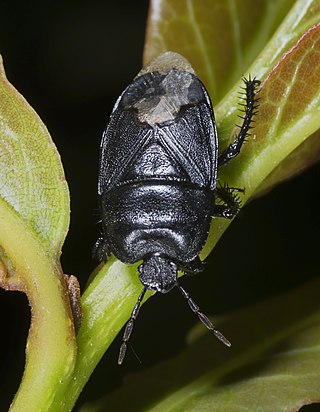
Cydnidae are a family of pentatomoid bugs, known by common names including burrowing bugs or burrower bugs. As the common name would suggest, many members of the group live a subterranean lifestyle, burrowing into soil using their head and forelegs, only emerging to mate and then laying their eggs in soil. Other members of the group are not burrowers, and live above the soil layer, often in close association with plants. Several species are known as agricultural pests.

Asopinae are a subfamily of stink bugs. They are predatory stink bugs that are useful as biological control agents against pests, even against other Pentatomid species, which are all herbivorous.

The flat-headed frog is a species of frog in the family Limnodynastidae. It is endemic to Australia. Its natural habitats are subtropical and tropical dry lowland grassland and freshwater marshes. It is threatened by habitat loss.

Broughton Island is an island 14 km north-east of Port Stephens on the Mid North Coast of New South Wales, Australia. It is part of the Myall Lakes National Park.(map)

Tessaratomidae is a family of true bugs. It contains about 240 species of large bugs divided into 3 subfamilies and 56 genera.
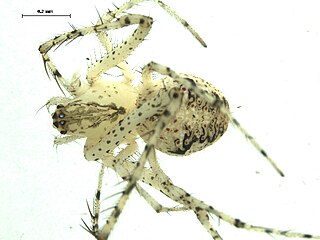
Mimetus notius is a species of pirate spiders in the family Mimetidae. It is found in the USA.

Carpocorini is a tribe of stink bugs in the family Pentatomidae. There are more than 100 genera in Carpocorini.

Epierus is a genus of clown beetles in the family Histeridae. There are more than 50 described species in Epierus.
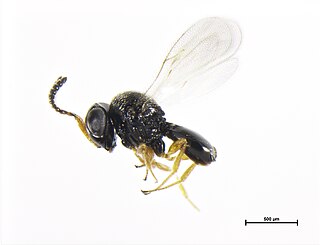
Trissolcus basalis, or the green vegetable bug egg parasitoid, is a parasitoid wasp in the family Platygastridae known primarily for parasitising the horticultural pest Nezara viridula, the green vegetable bug.

Notius is a genus of stink bugs, first described by Willam Sweetman Dallas in 1851.

Poecilocoris is a genus of shield-backed bugs in the family Scutelleridae. There are more than 20 described species in Poecilocoris, found mainly in south and east Asia, including Indomalaya.
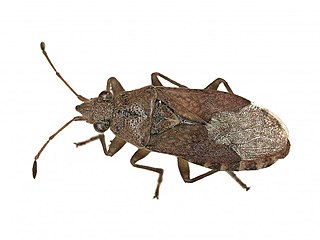
Orsillus is a genus of Palaearctic bugs, in the family Lygaeidae; it is the type genus of the subfamily Orsillinae and tribe Orsillini. Species are recorded from Europe and includes O. depressus which has become naturalised in the British Isles.
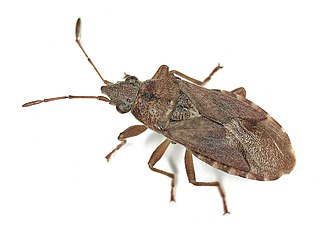
Orsillus depressus is a species of seed bug in the family Lygaeidae. It is a terrestrial insect native to southern Europe. It is considered a naturalized introduced species in the UK. O. depressus was first recorded in England in the 1980s and is now common throughout central and southern England. In southern Europe, its host plants are trees in Cupressaceae while in the UK Lawson's cypress is the most common host plant. O. depressus is approximately 6 mm in length and has a browny-orange coloration. Like many other species in Lygaeidae, O. depressus is a phytophagous species, feeding on plants, and it is commonly found in woodland/forest habitats and in cultivated areas of gardens and parks.

Notius consputus is a species of bug belonging to the stink bug family (Pentatomidae), first described by Carl Stål in 1865. It is found in Queensland, New South Wales, and Tasmania.

Plautia affinis is a species of stink bug found mainly in Queensland and New South Wales, Australia. It was first described in 1851 as Pentatoma affinis by William Sweetland Dallas. It is small, bright green and has brown hemelytra.



















